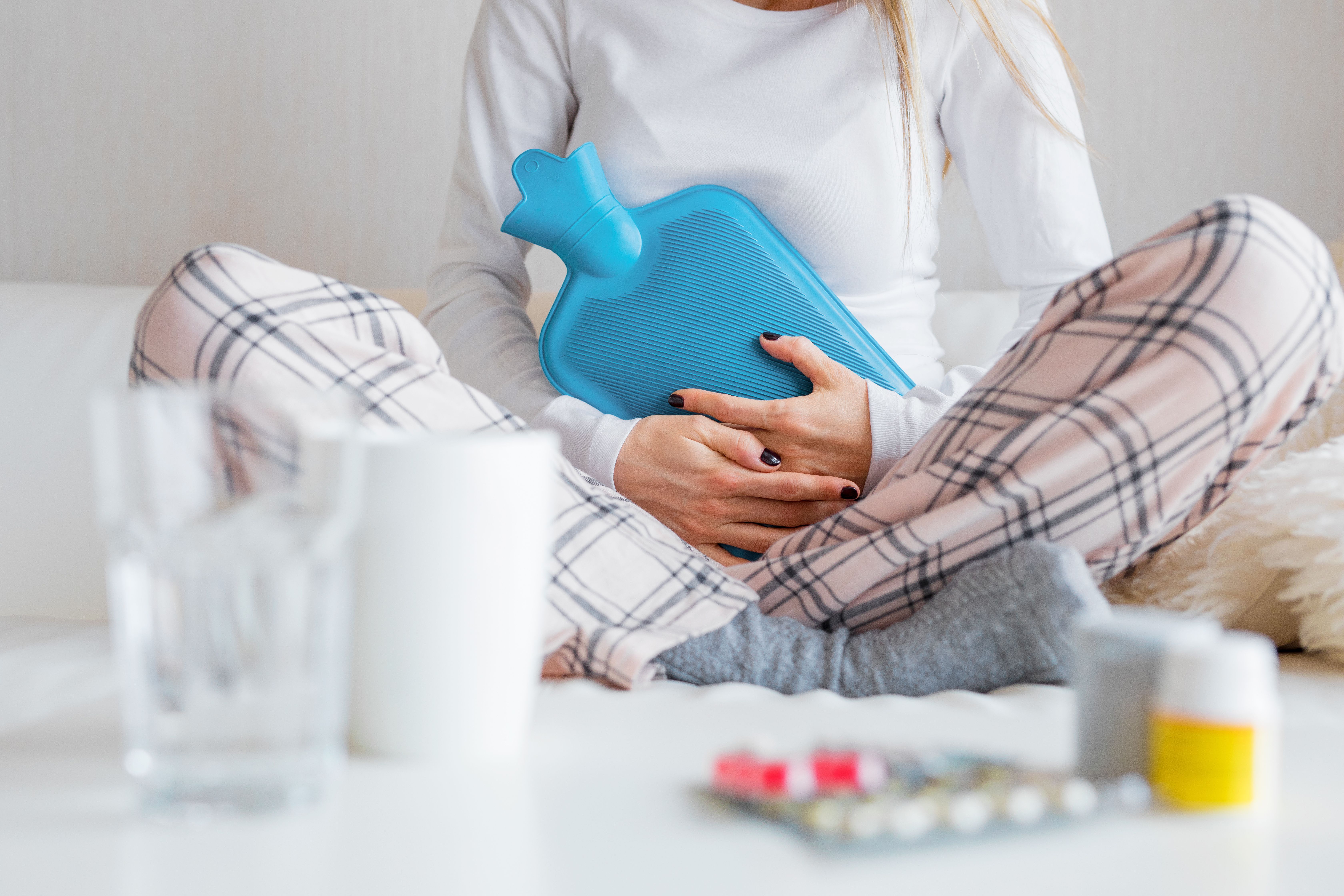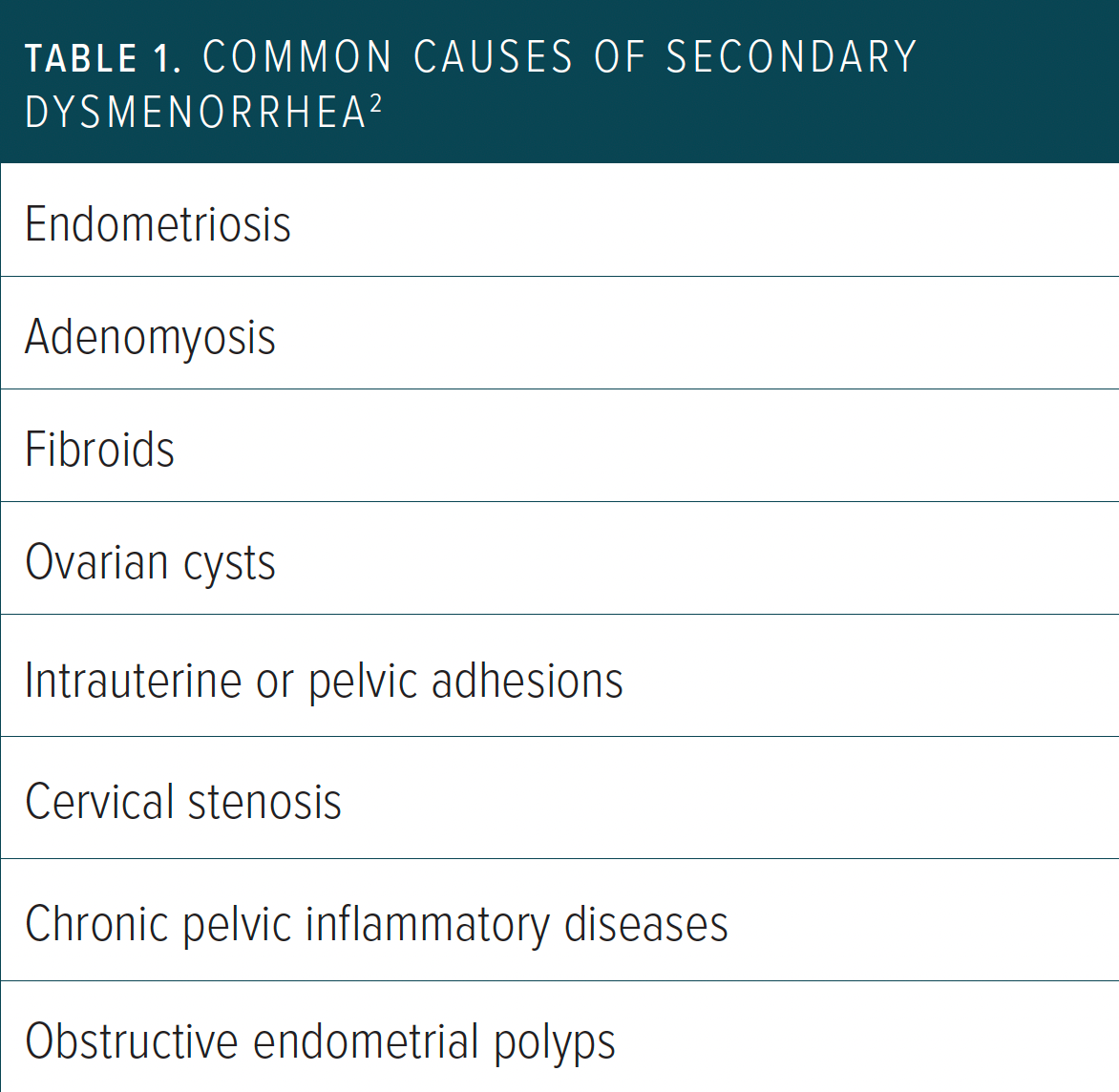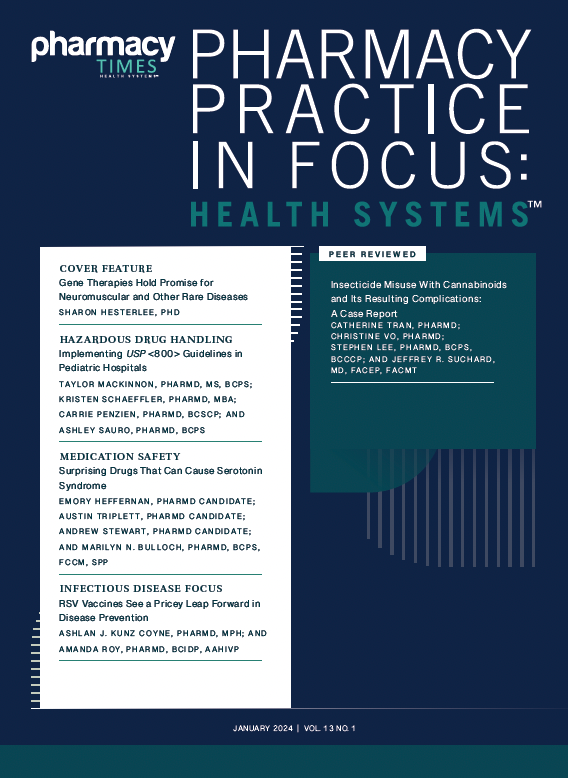Publication
Article
Pharmacy Practice in Focus: Health Systems
Give Your Patients Options for Managing Menstrual Pain
Author(s):
Recommendations range from contraceptives to heat therapy to holistic use of spices.
Dysmenorrhea is a condition characterized by painful menstruation and typically accompanied by negative emotional, physiological, and overall health effects.1 Symptoms can include muscle cramps, dizziness, headache, nausea, vomiting, and lower back pain, each with varying levels of severity.2 Dysmenorrhea also may affect sleep.
Image credit: Kaspars Grinvalds | stock.adobe.com

Dysmenorrhea occurs in approximately 50% to 90% of adolescent girls and premenopausal women.3 The pain occurs in the lower abdomen. It starts at the beginning of the menstrual flow and lasts between 8 to 72 hours. Factors contributing to dysmenorrhea include age, history of smoking, attempts to lose weight, high body mass index, depression, and family history (eg, endometriosis).2 Complications that accompany this condition, including pain intensity, anxiety, and vertigo, can affect patients’ daily lives.1
There are 2 types of dysmenorrhea: primary and secondary. Primary dysmenorrhea is described as pain with an unidentifiable cause experienced during the menstrual cycle, and it is one of the most common sources of pelvic pain in women.3 This can occur as a result of increased levels of prostaglandin and leukotriene, accompanied by inflammation, which can cause uterine smooth muscle contractions and painful cramps.2 The pathophysiology of primary dysmenorrhea is a result of the cyclooxygenase pathway producing prostaglandins.3 Further, an increase in prostaglandins can cause uterine contractions that restrict blood flow and increase the production of anaerobic metabolites that stimulate pain receptors.3 Primary dysmenorrhea typically occurs approximately 6 to 12 months after menarche, starts at the same time as the ovulation cycles, and occurs with every menstrual cycle.2
Secondary dysmenorrhea is caused by an identifiable medical condition, and it makes up approximately 10% of all cases of this disorder.2 The most common cause of this condition is endometriosis. Other causes include congenital or acquired abnormalities such as adenomyosis, pelvic masses, and infection (Table 1).2 In adenomyosis, cells grow deep into the uterine muscular wall, thickening the wall. The tissue does not extend outside the uterus, as in endometriosis. Secondary dysmenorrhea could start after menarche or later in life.2 It is accompanied by more consistent symptoms, such as progressive worsening of pelvic pain, abnormal uterine bleeding, vaginal discharge, and dyspareunia.2 Secondary dysmenorrhea is the most severe of the 2 conditions and is characterized by infertility, especially when caused by endometriosis. Other complications include pelvic organ prolapse, heavy bleeding, and anemia.2
Table 1: Common Causes of Secondary Dysmenorrhea

Role of the Pharmacist
Pharmacists can play a crucial role in helping patients manage menstrual pain. Their involvement primarily revolves around providing medication recommendations, offering counseling, and ensuring safe medication use. Specifically, pharmacists can counsel patients on self-care and medications, perform health screenings, and refer patients to physicians.
Patients in the preconception phase may experience symptoms of pain and cramping during menstrual cycles. Pharmacists can provide education on OTC medications to patients to support symptom relief and proper medication use. In some states, pharmacists may prescribe contraceptives to alleviate troublesome menstruation symptoms in addition to preventing pregnancy. If menstrual pain is severe, unresponsive to OTC medications, or accompanied by other symptoms (eg, heavy bleeding), pharmacists may recommend consulting a health care provider for further evaluation and treatment.
Effective Menstrual Pain Management
Severe menstrual pain can significantly impact an individual’s quality of life, making the effective management of menstrual pain essential. Although mild to moderate menstrual cramping is considered normal, intense pain can disrupt daily routines and prevent individuals from enjoying their usual activities. Implementing effective pain management strategies, such as medication and other treatments, is crucial to alleviate this discomfort and help maintain overall well-being and productivity.4-7
Self-Care and Lifestyle Interventions
Physical Activity
Physical activity can help diminish the severity and duration of pain experienced in primary dysmenorrhea. According to findings from a recent review, exercising 45 to 60 minutes at least 3 times a week, irrespective of intensity, can alleviate menstrual pain linked to moderate to severe dysmenorrhea. Exercise, although beneficial for overall health and well-being, does not directly target the prostaglandins or other specific biological mechanisms that cause menstrual pain and heavy flow in the same way nonsteroidal anti-inflammatory drugs (NSAIDs) do. Therefore, its efficacy in reducing menstrual pain or flow may not be as pronounced as that of NSAIDs.8,9
Heat Therapy
Heating pads, warm baths, and hot water bottles offer several benefits. Heat therapy promotes muscle relaxation in the lower abdomen and pelvic area, which can alleviate the intensity of uterine contractions responsible for pain. Additionally, heat therapy improves blood circulation, reducing congestion and discomfort. It also provides immediate pain relief and can make menstrual cramps more tolerable.10,11
Water Intake
Study results suggest that drinking 7 to 8 cups of water daily can help alleviate the severity of primary dysmenorrhea, shorten the length of menstrual bleeding, and reduce the average number of pain relievers taken during menstruation.12
Diet
Dietary choices can play a pivotal role in managing the symptoms and reducing the impact of dysmenorrhea. An anti-inflammatory diet, characterized by an abundance of fruits, vegetables, and whole grains, can help mitigate inflammation in the body, which is closely linked to the severity of menstrual cramps. Furthermore, incorporating ω-3 fatty acids from sources such as fatty fish, flaxseeds, and walnuts can provide natural anti-inflammatory effects and alleviate menstrual pain.13
Nonpharmacological Treatments
Cinnamon
The essential oils in cinnamon include cinnamaldehyde (55%-57%) and eugenol (5%-18%). It has been reported that cinnamaldehyde has an antispasmodic effect, and eugenol can inhibit the biosynthesis of prostaglandins and alleviate inflammation. Therefore, cinnamon is considered to inhibit the proteinoid system, which is involved in prostaglandin E2 (PGE2) generation. Moreover, the efficacy of cinnamon in the management of dysmenorrhea is ascribed to its potent tocolytic effect, which can reduce uterine activity regardless of how the force is produced.14
The type of cinnamon (Ceylon vs cassia) and its dosage should be considered. Ceylon cinnamon is generally preferred because of its lower coumarin content, which can be harmful in large quantities. It’s important to consider the individual’s medical history and any allergies before recommending cinnamon. For example, individuals with liver disorders, surgery patients, or those on certain medications should consult with a health care provider before using cinnamon because it has blood-thinning properties.
Fennel
Fennel’s efficacy in relieving spasms induced by oxytocin and PGE2 has been studied in experiments using mouse uteri. A systematic analysis of these experiments provided clear evidence that fennel can substantially reduce the pain intensity associated with primary dysmenorrhea.14 Fennel can be suggested for individuals experiencing mild to moderate menstrual cramps. It’s especially suitable for those who are interested in natural or alternative remedies.
Ginger
Ginger contains a variety of useful substances such as gingerols, free fatty acids, carbohydrates, and proteins. It is reported to have analgesic and anti-inflammatory effects. Ginger can inhibit leukotrienes and the synthesis of PGs by suppressing the enzyme cyclooxygenase (COX). With similar efficacy as ibuprofen, mefenamic acid, and Novafen (acetaminophen, ibuprofen, caffeine), ginger can relieve pain in women with primary dysmenorrhea. A meta-analysis on the efficacy of oral ginger for managing dysmenorrhea suggested that oral ginger is more effective in relieving pain severity than placebo.15
Ginger can be consumed in various forms such as fresh ginger root, tea, capsules, or extracts. Dosages may vary, but a general guideline is 500 mg to 1000 mg of ginger per day, starting at the onset of menstrual symptoms.15
Pharmacological Treatments
Nonsteroidal Anti-Inflammatory Drugs
These medications are considered first-line treatments for managing menstrual pain (Table 28). They work by inhibiting the action of the COX enzyme, which leads to a reduction in the production of prostaglandins. As a result, the concentration of prostaglandins in menstrual fluid decreases, which leads to reduced uterine contractions and a decrease in menstrual volume. These drugs generally have few adverse effects (AEs) and are well tolerated, but the most common AEs are gastrointestinal symptoms such as nausea, vomiting, and heartburn. There is currently limited evidence to determine which NSAID is the most effective or the safest, but commonly used ones are ibuprofen, naproxen, mefenamic acid, and ketoprofen. These medications are most effective when taken before the onset of symptoms and should be continued for 3 days.8
Table 2: Nonsteroidal Anti-Inflammatory Drugs -- Doses and Adverse Effects

Hormonal Therapy, Estrogen-Progestin
Combined estrogen-progestin oral contraceptives are the second line of treatment and are effective in adolescents and adults with primary dysmenorrhea. They can significantly decrease pain and the need for and dose of analgesics. These contraceptives contain synthetic progestins, suppressing ovulation and thinning the endometrium, which lowers arachidonic acid levels, the precursor of prostaglandin synthesis. Consequently, they reduce uterine bleeding and contractions during menstruation, lessening dysmenorrhea. According to American Family Physician, “continuous combined oral contraceptive regimens with more than 28 days of active hormone may lead to improved and more rapid pain relief but are associated with more weight gain than cyclic regimens.”2
Hormonal Therapy, Progestin-Only Pills
The progestin component in estrogen-progestin contraceptives is responsible for inducing endometrial atrophy, which ultimately relieves dysmenorrhea. Progestin-only oral contraceptives are an alternative for individuals who are not candidates for estrogen therapy. They have the potential to be effective in treating primary dysmenorrhea, although they haven’t been as extensively researched as estrogen-progestin contraceptives. Some AEs, notably irregular bleeding, are more common with progestin-only methods compared with estrogen-progestin contraceptives.8
Combination products for menstrual pain are OTC medications that blend multiple active ingredients such as pain relievers (eg, ibuprofen or acetaminophen), antispasmodics, caffeine, and diuretics (eg, pamabrom). These products are designed to simultaneously address various symptoms associated with menstruation, including cramps, bloating, and fatigue. Although they offer the convenience of multisymptom relief in 1 medication, it’s crucial to be mindful of the ingredients and their dosages to avoid overdose and to ensure they align with the individual’s specific health needs.
Conclusion
Dysmenorrhea is a common condition that affects a significant percentage of women. The 2 main types, primary and secondary dysmenorrhea, present unique challenges and often require a multifaceted approach to management. Although pharmacists can provide medication and recommendations, nonpharmacological approaches such as physical activity, heat therapy, hydration, and a balanced diet offer holistic solutions. Herbal remedies such as cinnamon, fennel, and ginger also show potential. Recognizing the complexity of dysmenorrhea and adopting a patient-centered strategy can significantly enhance the well-being of those affected by this prevalent condition.
References
1. Nagy H, Carlson K, Khan MAB. Dysmenorrhea. In: StatPearls. StatPearls Publishing; 2023. Accessed December 6, 2023. https://www.ncbi.nlm.nih.gov/books/NBK560834/
2. McKenna KA, Fogleman CD. Dysmenorrhea. Am Fam Physician. 2021;104(2):164-170.
3. Ferries-Rowe E, Corey E, Archer JS. Primary dysmenorrhea: diagnosis and therapy. Obstet Gynecol. 2020;136(5):1047-1058. doi:10.1097/AOG.0000000000004096
4. Ceulemans M, Liekens S, Van Calsteren K, Allegaert K, Foulon V. Community pharmacists’ attitudes, barriers, knowledge and counseling practice with regard to preconception, pregnancy and lactation. Res Social Adm Pharm. 2020;16(9):1192-1200. doi:10.1016/j.sapharm.2019.12.010
5. DiPietro Mager N, Bright D, Shipman AJ. Beyond contraception: pharmacist roles to support maternal health. Pharmacy (Basel). 2022;10(6):163. doi:10.3390/pharmacy10060163
6. Suaidi MT, Wong PK, Mohd Tahir NA, Chua EW. Community pharmacists’ knowledge, attitude, and practice in providing self-care recommendations for the management of premenstrual syndrome. Medicina (Kaunas). 2020;56(4):181. doi:10.3390/medicina56040181
7. Armour M, Smith CA, Steel KA, Macmillan F. The effectiveness of self-care and lifestyle interventions in primary dysmenorrhea: a systematic review and meta-analysis. BMC Complement Altern Med. 2019;19(1):22. doi:10.1186/s12906-019-2433-8
8. Guimarães I, Póvoa AM. Primary dysmenorrhea: assessment and treatment. Rev Bras Ginecol Obstet. 2020;42(8):501-507. doi:10.1055/s-0040-1712131
9. Matthewman G, Lee A, Kaur JG, Daley AJ. Physical activity for primary dysmenorrhea: a systematic review and meta-analysis of randomized controlled trials. Am J Obstet Gynecol. 2018;219(3):255.e1-255.e20. doi:10.1016/j.ajog.2018.04.001
10. French L. Dysmenorrhea. Am Fam Physician. 2005;71(2):285-291.
11. Potur DC, K.mürcü N. The effects of local low-dose heat application on dysmenorrhea. J Pediatr Adolesc Gynecol. 2014;27(4):216-221. doi:10.1016/j.jpag.2013.11.003
12. Torkan B, Mousavi M, Dehghani S, et al. The role of water intake in the severity of pain and menstrual distress among females suffering from primary dysmenorrhea: a semi-experimental study. BMC Womens Health. 2021;21(1):40. doi:10.1186/s12905-021-01184-w
13. Harel Z, Biro FM, Kottenhahn RK, Rosenthal SL. Supplementation with omega-3 polyunsaturated fatty acids in the management of dysmenorrhea in adolescents. Am J Obstet Gynecol. 1996;174(4):1335-1338. doi:10.1016/ s0002-9378(96)70681-6
14. Xu Y, Yang Q, Wang X. Efficacy of herbal medicine (cinnamon/fennel/ginger) for primary dysmenorrhea: a systematic review and meta-analysis of randomized controlled trials. J Int Med Res. 2020;48(6):300060520936179. doi:10.1177/0300060520936179
15. Chen CX, Barrett B, Kwekkeboom KL. Efficacy of oral ginger (Zingiber officinale) for dysmenorrhea: a systematic review and meta-analysis. Evid Based Complement Alternat Med. Published online May 5, 2016. doi:10.1155/2016/6295737
About the Authors
Omolara Falade, Janet John, and Yulianna Laurencin are PharmD candidates in the Department of Pharmacy Practice at Texas A&M University’s Irma Lerma Rangel School of Pharmacy in Kingsville.
Chinonso Paul is a PharmD and MBA candidate at Texas A&M University’s Irma Lerma Rangel School of Pharmacy in Kingsville.
Sara Rogers, PharmD, BCPS, is a clinical assistant professor of precision medicine and ambulatory care at Texas A&M University’s Irma Lerma Rangel College of Pharmacy; clinical specialist at Texas A&M Physicians Clinic; clinical assistant professor in the Department of Translational Medical Sciences, Texas A&M Health Science Center, in Bryan; and cofounder and president of the American Society of Pharmacovigilance.






